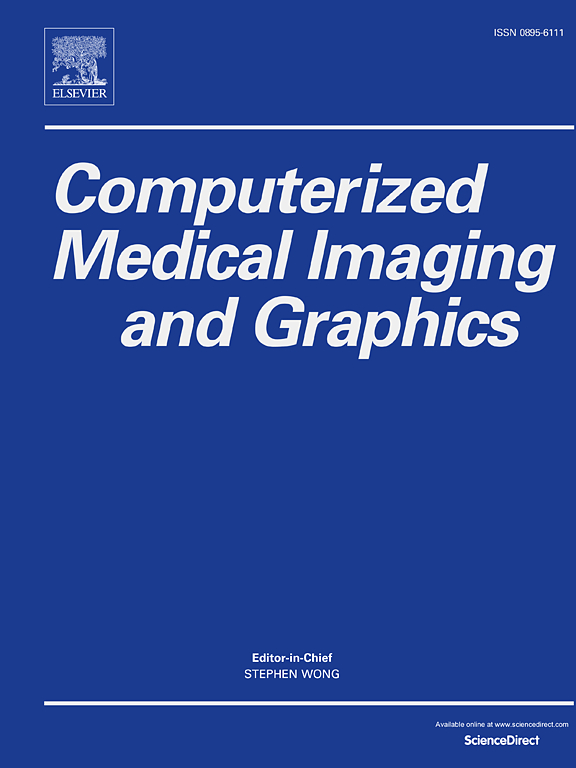颞叶融合和基于注意的CNN在x线冠状动脉造影术中狭窄的检测
IF 5.4
2区 医学
Q1 ENGINEERING, BIOMEDICAL
Computerized Medical Imaging and Graphics
Pub Date : 2025-02-23
DOI:10.1016/j.compmedimag.2025.102513
引用次数: 0
摘要
背景与目的:冠状动脉疾病(CAD)是由动脉粥样硬化斑块积聚引起的,是导致死亡的主要原因。诊断CAD的金标准是在经皮冠状动脉介入治疗期间通过x线冠状动脉造影(XCA),其中定位冠状动脉狭窄是基础和必要的。然而,由于复杂的血管特征以及心跳和呼吸运动引起的运动伪影,人工识别狭窄对医生来说是一个挑战,这可能会延长手术决策时间,导致不可逆的心肌损伤。因此,我们的目标是提供一种准确定位狭窄的自动方法。方法:在这项工作中,我们提出了一个具有特征级时间融合和注意模块的卷积神经网络(CNN)来检测XCA图像中的冠状动脉狭窄。提出了由可变形卷积和基于相关的时间融合模块组成的时间融合模块,对连续帧的时变血管特征进行融合。注意模块采用通道方向的再校准来捕捉全局上下文,采用空间方向的再校准来利用局部宽度和形态信息增强狭窄特征。结果:我们将我们的方法与常用的注意方法、最先进的目标检测方法和狭窄检测方法进行了比较。实验结果表明,我们的融合和注意策略显著提高了识别狭窄的性能(P<0.05),在两个不同的数据集上获得了最佳的平均召回分数。结论:本研究首次将时间融合和注意机制整合到XCA图像狭窄检测的新型特征级混合CNN框架中,该框架有效提高了检测性能,因此可能有助于术中狭窄定位。本文章由计算机程序翻译,如有差异,请以英文原文为准。
Intraoperative stenosis detection in X-ray coronary angiography via temporal fusion and attention-based CNN
Background and objective:
Coronary artery disease (CAD), the leading cause of mortality, is caused by atherosclerotic plaque buildup in the arteries. The gold standard for the diagnosis of CAD is via X-ray coronary angiography (XCA) during percutaneous coronary intervention, where locating coronary artery stenosis is fundamental and essential. However, due to complex vascular features and motion artifacts caused by heartbeat and respiratory movement, manually recognizing stenosis is challenging for physicians, which may prolong the surgery decision-making time and lead to irreversible myocardial damage. Therefore, we aim to provide an automatic method for accurate stenosis localization.
Methods:
In this work, we present a convolutional neural network (CNN) with feature-level temporal fusion and attention modules to detect coronary artery stenosis in XCA images. The temporal fusion module, composed of the deformable convolution and the correlation-based module, is proposed to integrate time-varifying vessel features from consecutive frames. The attention module adopts channel-wise recalibration to capture global context as well as spatial-wise recalibration to enhance stenosis features with local width and morphology information.
Results:
We compare our method to the commonly used attention methods, state-of-the-art object detection methods, and stenosis detection methods. Experimental results show that our fusion and attention strategy significantly improves performance in discerning stenosis (), achieving the best average recall score on two different datasets.
Conclusions:
This is the first study to integrate both temporal fusion and attention mechanism into a novel feature-level hybrid CNN framework for stenosis detection in XCA images, which is proved effective in improving detection performance and therefore is potentially helpful in intraoperative stenosis localization.
求助全文
通过发布文献求助,成功后即可免费获取论文全文。
去求助
来源期刊
CiteScore
10.70
自引率
3.50%
发文量
71
审稿时长
26 days
期刊介绍:
The purpose of the journal Computerized Medical Imaging and Graphics is to act as a source for the exchange of research results concerning algorithmic advances, development, and application of digital imaging in disease detection, diagnosis, intervention, prevention, precision medicine, and population health. Included in the journal will be articles on novel computerized imaging or visualization techniques, including artificial intelligence and machine learning, augmented reality for surgical planning and guidance, big biomedical data visualization, computer-aided diagnosis, computerized-robotic surgery, image-guided therapy, imaging scanning and reconstruction, mobile and tele-imaging, radiomics, and imaging integration and modeling with other information relevant to digital health. The types of biomedical imaging include: magnetic resonance, computed tomography, ultrasound, nuclear medicine, X-ray, microwave, optical and multi-photon microscopy, video and sensory imaging, and the convergence of biomedical images with other non-imaging datasets.

 求助内容:
求助内容: 应助结果提醒方式:
应助结果提醒方式:


